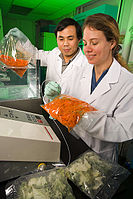
Photo from wikipedia
The 2030 Agenda of the United Nations includes the objective of setting up sustainable production patterns by pursuing several Sustainable Development Goals. Among them, the "Responsible production and consumption" is… Click to show full abstract
The 2030 Agenda of the United Nations includes the objective of setting up sustainable production patterns by pursuing several Sustainable Development Goals. Among them, the "Responsible production and consumption" is a key topic in the food production and is strictly connected with the "Climate action"; the crucial point, however, is how to jointly act on all these aspects and apply them in practice. The waste yearly produced in the food chain represent both an ethical, economic and environmental issue. In particular, as far as the recovery of packaged food waste from retailers is concerned, the valorisation of the wasted meat is an extremely relevant issue. Pet food industries could be interested in valorising this waste fraction to replace meat coming from slaughters in their product recipes. This article evaluates the environmental impact of valorising meat fraction from packaged food waste to produce two different recipes of high quality pet food, called Natura and Pâté. A life cycle assessment of the current scenario (traditional pet food production and landfilling of packaged food waste) and of a new one (pet food production using meat fraction from packaged food waste) is carried out applying the ReCiPe 2016 method of impact assessment. Real data have been taken from retailers and pet food manufacturer. The production of pet food using the meat fraction from packaged food waste generates on average lower environmental impacts if compared to the traditional process, in terms of GWP (-56.40%), water consumption (-22.62%), land use (-87.50%) and fossil resource scarcity (-21.78%). Benefits are interesting even if considering the production of Pâté (-14.66%), for which the traditional production process makes use of some slaughter by-products. The proposed industrial process is demonstrated to be sustainable from an environmental point of view and appears to be in line with Sustainable Development Goals (SDGs) 2, 12 and 13.
Journal Title: Waste management
Year Published: 2021
Link to full text (if available)
Share on Social Media: Sign Up to like & get
recommendations!